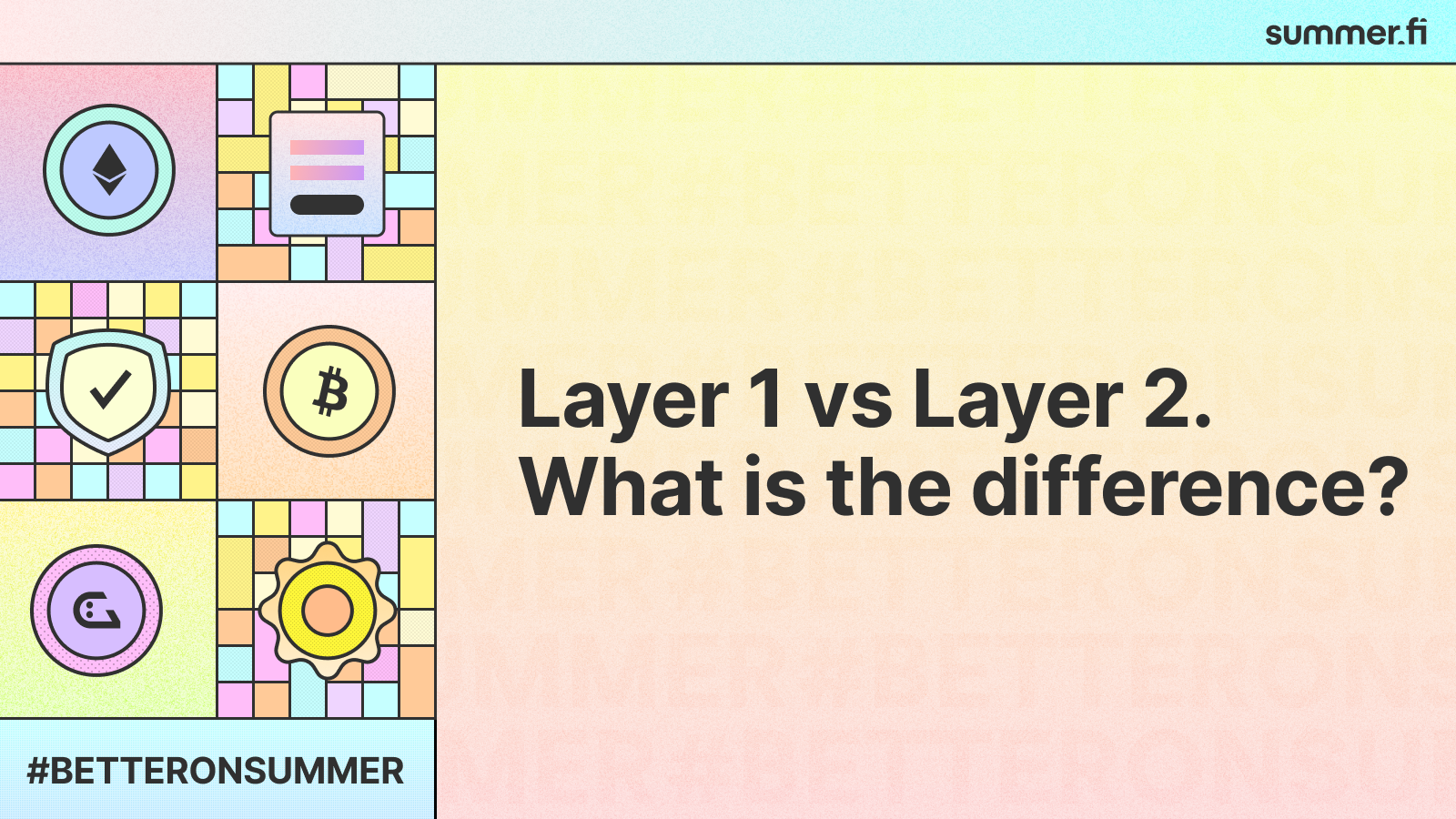Exploring Blockchain Scalability: Layer 1 vs. Layer 2 Solutions

More and more people are getting into crypto and blockchain, leading to a lot more transactions. While blockchain is amazing, making it handle all these transactions, known as scalability, is tough. Public blockchains that are super secure and decentralized often struggle to handle a lot of transactions quickly.
This is called the Blockchain Trilemma. It basically says that it's really hard for a decentralized system to be super decentralized, super secure, and super scalable all at once. In reality, you can only pick two out of the three.
Luckily, there are thousands of people trying to fix this. Some are tweaking the main blockchain (Layer 1), while others are focusing on Layer 2, which sits on top of the main network.
With so many different blockchains and cryptocurrencies out there, it can be confusing to know if you're using a Layer 1 or Layer 2 chain. But it's helpful to understand what you're dealing with if you're investing or using them. Let's break down the differences between Layer 1 and Layer 2 blockchains and how they handle scalability.
After reading this article, you are invited to explore L2 opportunities available in our app: https://summer.fi/
What Are Layer 1 and Layer 2?
Layer 1 is like the foundation of a blockchain. It's the main structure. Bitcoin, Ethereum, and BNB Chain are examples. Layer 2, on the other hand, sits on top of other blockchains. For instance, the Lightning Network is a Layer 2 on top of Bitcoin. When it comes to improving scalability, solutions can be either Layer 1 or Layer 2.
Why Does Scalability Matter?
Imagine a road connecting a big city to its growing suburb. As more cars use the road, it gets congested, especially during rush hours. Similarly, blockchains have limits on how many transactions they can handle at once. If the demand exceeds the capacity, things slow down and become expensive.
In blockchain technology, Layer 1 represents the main network, while Layer 2 solutions act as secondary networks to boost capacity.
Bitcoin, Ethereum, and Polkadot are Layer 1 blockchains processing transactions within their ecosystems. They use native cryptocurrencies for fees and utility. Polygon is a Layer 2 scaling solution for Ethereum, updating the mainnet with checkpoints regularly.
Throughput capacity, measuring transaction speed and efficiency within a timeframe, is crucial for blockchains. As user numbers and transactions rise, Layer 1 blockchains, especially those using Proof of Work, can become slow and expensive.
Layer 1 issues
Bitcoin and Ethereum illustrate Layer 1 networks grappling with scalability challenges. They employ a distributed consensus model to secure the network, requiring multiple nodes to verify transactions before validation. Mining nodes engage in competitive puzzle-solving to validate transactions and earn rewards in the network's native cryptocurrency.
In essence, every transaction undergoes independent verification by numerous nodes, ensuring accurate data recording while minimizing the risk of malicious activity. However, as Ethereum and Bitcoin grow in popularity, throughput demands surge. Consequently, network congestion leads to prolonged confirmation times and escalated transaction fees for users.
How Layer 1 and Layer 2 Solutions Work
Layer 1 solutions directly change the main blockchain's rules and mechanisms. Layer 2 solutions, on the other hand, use external networks to process transactions separately from the main one.
Layer 1 Solutions
Layer 1 solutions include changes made by the blockchain's developers. Sometimes, these changes require everyone to agree (a hard fork), while others are smaller and more flexible (a soft fork). Solutions like increasing block sizes or using sharding are examples.
Layer 2 Solutions
Layer 2 solutions work alongside the main blockchain, processing transactions in parallel. Methods like rollups, sidechains, state channels, and nested blockchains all aim to speed up transactions without overloading the main chain.
Rollups:
Zero-knowledge rollups, the most common type, bundle Layer 2 transactions off-chain and present them as a single transaction on the main chain. These systems employ validity proofs to ensure transaction integrity. Assets remain on the original chain through a bridging smart contract, which confirms the proper functioning of the rollup. This setup combines the security of the original network with the efficiency of a less resource-intensive rollup.
Sidechains:
Sidechains are autonomous blockchain networks with their own validators. In this setup, the bridging smart contract on the main chain does not validate the sidechain's transactions. Therefore, users must trust that the sidechain operates correctly, as it controls assets on the original chain.
State channels:
A state channel establishes a two-way communication environment between transacting parties. They isolate a portion of the underlying blockchain and link it to an off-chain transaction channel. Typically governed by a pre-agreed smart contract or multi-signature, parties conduct transactions off-chain without immediately submitting data to the main chain. Once transactions are complete, the channel's final state is broadcast to the blockchain for validation, enhancing transaction speed and network capacity. Solutions like the Bitcoin Lightning Network and Ethereum's Raiden leverage state channels.
Nested blockchains:
This approach employs secondary chains atop the main "parent" blockchain. Nested blockchains adhere to the rules and parameters set by the parent chain. The main chain does not execute transactions; its role is limited to resolving disputes when necessary. "Child" chains handle day-to-day transactions, returning processed transactions to the main chain upon completion.
Challenges of Layer 1 and Layer 2 Solutions
Both Layer 1 and Layer 2 solutions come with their own set of pros and cons. Opting for Layer 1 can offer the most efficient solution for significant protocol enhancements. However, it necessitates convincing validators to accept changes through a hard fork.
For instance, transitioning from Proof of Work to Proof of Stake may face resistance from miners who stand to lose income with the adoption of a more efficient system. This disincentivizes them from supporting scalability improvements.
On the other hand, Layer 2 offers a faster route to scalability enhancement. Yet, depending on the method employed, it may compromise the security of the original blockchain. Users rely on networks like Ethereum and Bitcoin for their robustness and established security track record. By delegating certain functions to Layer 2, there's a reliance on the Layer 2 team and network for both efficiency and security.
Future
A critical question arises: do we really need Layer 2 solutions as Layer 1 networks become more scalable? While existing blockchains undergo improvements and new networks emerge with robust scalability, the journey towards enhancing scalability for major systems will likely be lengthy and uncertain. It's probable that Layer 1 networks will prioritize security, allowing Layer 2 networks to cater their services to specific use cases.
In the foreseeable future, dominant chains like Ethereum are poised to maintain their stronghold, thanks to their expansive user and developer community. However, Ethereum's extensive decentralized validator set and trusted reputation lay a sturdy foundation for tailored Layer 2 solutions.
Layer 2 is Better on Summer
L2s have become an Ethereum sensation lately, and rightfully so. Their scalability and cost reductions are transforming the game. Using the power of L2s gives you unparalleled high-speed capabilities, slashing transaction costs by over 40x.
Say goodbye to excessive gas fees!
With the boost from our L2s enhancement, you can amplify both your long and short positions, fully integrating the best of our curated list of protocols and features into our platform.
Summer.fi L2 products offer:
- Rapid and user-friendly management of Multiply positions.
- A streamlined app for overseeing transactions.
- A substantial cut in gas fees.
- Features like one-click actions and an adjustable slider to navigate with ease.
The quest for better scalability in blockchain has led to a mix of improvements at Layer 1 and Layer 2. Whether you're invested in crypto or just curious, understanding the differences between these layers and their scaling solutions gives you a clearer picture of the crypto landscape.
If you are looking for something new, we invite you to Summer.fi – the best place to Borrow and Earn in DeFi. Learn more in our blog: https://blog.summer.fi/
Getting in touch
If you have any questions regarding Summer.fi, contact us at support@summer.fi or our social media.

